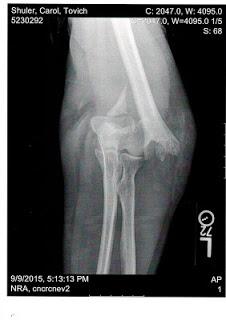
X-rays of the comminuted fracture in
Carol Shuler's arm, showing it broke
into more than two pieces.
We've already shown that Carol was seat-belted and restrained in the patrol car, so she was not able to flail about. But even if she had, her injuries are not consistent with any form of self abuse. They are consistent with trauma, and that's why they required trauma surgery (not orthopedic surgery) for repair.
We recently obtained a copy of Carol's records from Cox Medical Center in Springfield, Missouri, where her broken arm was diagnosed and treated. An individual who is knowledgeable about such cases instructed us to look for any notations about a "spiral" fracture, which involves a twisting action and could not be caused by bumping about in a vehicle. It turns out that Carol's records show her injuries were significantly worse than a spiral fracture. (A document from her medical records is embedded at the end of this post.)
Here are findings from an exam at 5:25 p.m. on 9/9/15, the date of our eviction and Carol's injuries. Dr. Jock D. Porter ordered the X-rays, with interpretation from Dr. Kan Ying:
Bones: A large comminuted fracture involving the distal humeral metaphysis. The distal fracture is displaced medially for about 3.5 cm and posteriorly for about 6 mm. There could also be overlapping between proximal and distal fragements for about 15 mm.
These are not words you want to see on your medical chart. They mean your arm has met with violence of a traumatic nature. Consider the definition of a "comminuted fracture:"
A comminuted fracture is a break or splinter of the bone into more than two fragments. Since considerable force and energy is required to fragment bone, fractures of this degree occur after high-impact trauma such as in vehicular accidents.
External fixation devices such as splints and casts are usually inadequate in treating this type of fracture. Repairing a comminuted fracture often requires open surgery to restructure the bone to normal anatomy.
In a spiral fracture, the bone is broken into two or fewer pieces, and surgery usually is not required:
You may develop a spiral fracture pattern in the humerus due to some twisting injuries. You develop it in the shaft of the humerus when you lock your lower arm or have it trapped in machinery while the body rotates. Similarly, direct twisting forces applied during arm wrestling or throwing may also cause a spiral fracture in humerus.
Into how many pieces did Carol's arm break? We have posted X-rays that show at least three distinct pieces. Members of her treatment team told us her injury involved a pulverizing action that left a large number of tiny bone fragments. Some of these were preserved and put back into place for healing, others had to be washed away. It's likely that Carol's bone broke into several dozen pieces; we just don't know. We do know that it was much worse than a spiral fracture.
We also know this type of injury is not seen very often. People hurt themselves from banging into stuff all the time. They don't hurt themselves this way very often; this kind of injury is inflicted upon them:
Distal humerus fractures are uncommon; they account for just about 2 percent of all adult fractures. They can occur on their own, with no other injuries, but can also be a part of a more complex elbow injury.
A "more complex elbow injury?" Yes, the kind where a thuggish cop almost rips your arm off at the elbow -- and then his colleagues lie about it.
